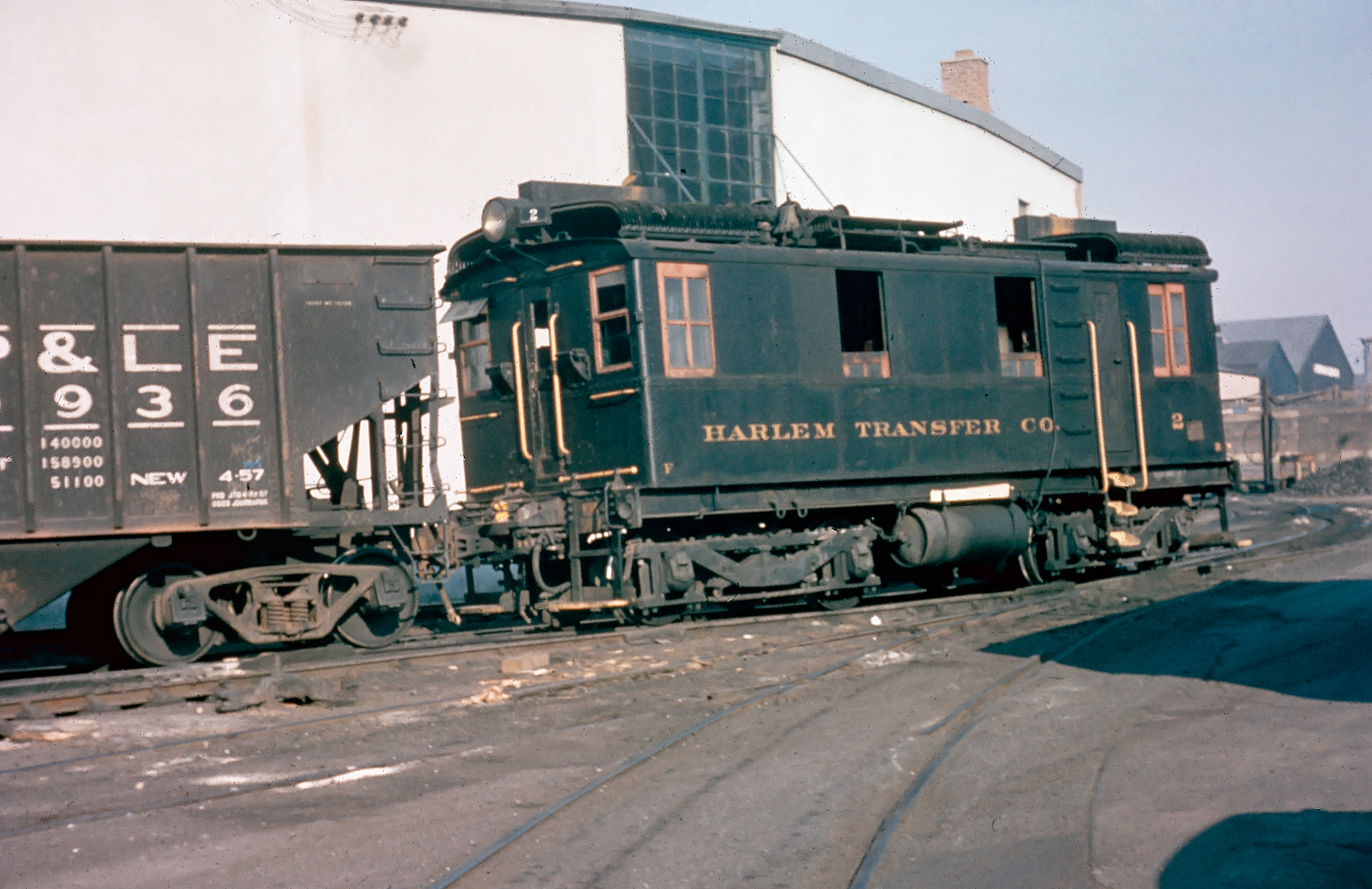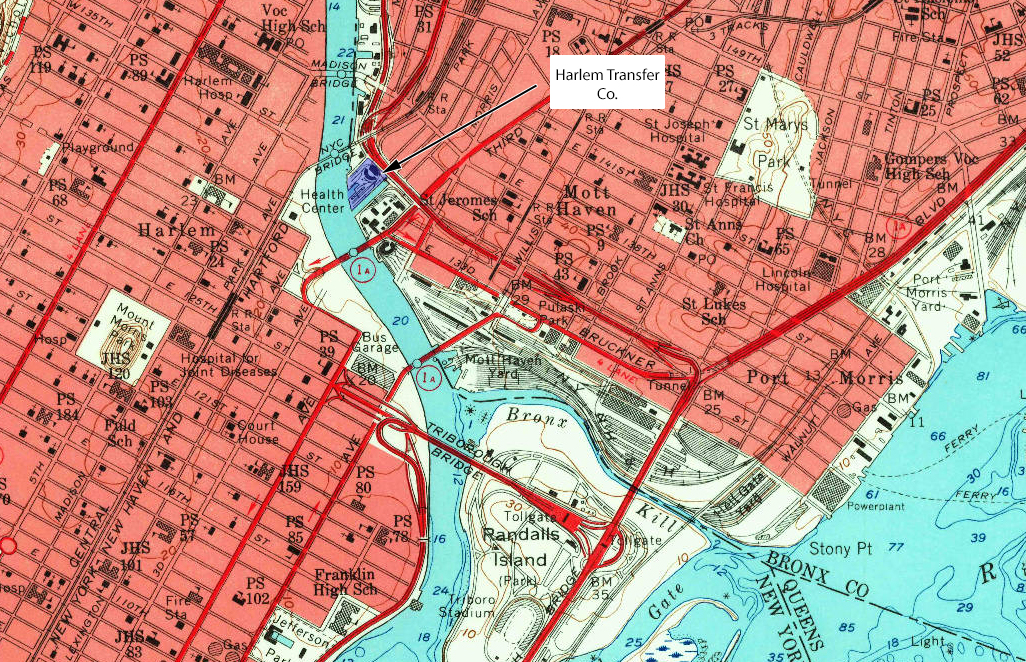Harlem Transfer Company: An NYC Terminal System
Published: July 15, 2024
By: Adam Burns
The Harlem Transfer Company stands as a notable chapter in the historical tapestry of American rail and freight transportation, playing a pivotal role in the interchange of goods between railroads and customers in New York City.
Established in the late 19th century, the company facilitated the seamless transfer of freight between Harlem River's waterfront, the burgeoning network of railroads, and the dense urbanfabric of Manhattan and its surrounding boroughs.
 Harlem Transfer Company 60-ton boxcab #2 is seen here at its facility in the Bronx (New York), circa 1960. This 300 horsepower switcher was manufactured by Alco/GE/Ingersoll-Rand in June, 1926, ordered as Lackawanna #3002. However, the locomotive was transferred to DL&W-subsidiary Harlem Transfer, remaining in service until February, 1962. It was scrapped later that year in November. Meyer Pearlman photo. American-Rails.com collection.
Harlem Transfer Company 60-ton boxcab #2 is seen here at its facility in the Bronx (New York), circa 1960. This 300 horsepower switcher was manufactured by Alco/GE/Ingersoll-Rand in June, 1926, ordered as Lackawanna #3002. However, the locomotive was transferred to DL&W-subsidiary Harlem Transfer, remaining in service until February, 1962. It was scrapped later that year in November. Meyer Pearlman photo. American-Rails.com collection.Origins and Foundation
Established in 1898, the Harlem Transfer Company was a pioneer among the so-called "pocket terminals" strategically located in the Bronx along the Harlem River.
Positioned at the intersection of Park Avenue (formerly Railroad Avenue) and East 135th Street, the facility was originally built, owned, and operated by the Erie Railroad.
Between 1898 and 1906, the terminal evolved into a joint operation, accommodating several other railroads.
When the Harlem Transfer facility first commenced operations, it primarily facilitated interchange with the Erie Railroad, Central Railroad of New Jersey, and the Delaware, Lackawanna & Western Railroads.
By 1902, the Baltimore & Ohio would also join, leveraging this crucial hub for their interchange needs.
In 1906, the Delaware, Lackawanna & Western Railroad acquired the Harlem Transfer property outright, assuming exclusive control over its operations while maintaining company as a subsidiary under its original name.
This strategic move necessitated that other railroads construct their own carfloat terminals along the Harlem River. However, the Erie Railroad maintained its presence at the facility into the 1930s.
The Harlem Transfer boasted its own tugboats and locomotives, distinct from those in the DL&W roster. Notably, the facility's freighthouse was an unusual architectural feat.
Infrastructure and Operations
The core infrastructure comprised several key components:
1. **Rail Yards:** Extensive rail yards allowed for the sorting, storage, and transfer of freight cars. These yards were equipped with numerous tracks to accommodate the high volume of rail traffic and facilitate smooth operations.
2. **Docks and Piers:** Given the strategic location by the Harlem River, docks and piers were integral to the company's operations. These facilities enabled the offloading of goods transported via barges and ships, seamlessly integrating waterborne transport with rail and road.
3. **Warehouses:** Massive warehouses provided secure storage for goods awaiting transfer. These structures were engineered to handle a variety of cargo types, ranging from bulk commodities to manufactured products.
4. **Transfer Platforms:** Specialized platforms and cranes were utilized to transfer goods between rail cars and trucks. This included state-of-the-art equipment for the era, ensuring that even heavy or bulky items could be handled efficiently.
DL&W Directory
The Lackawanna's directory of industries from the 1950s noted the following about the operation:
HARLEM TRANSFER COMPANY'S TERMINAL - NEW YORK CITY, N.Y.
Located on Bronx side of Harlem River between Park Avenue and Mott Haven Canal, extending from 135th Street to Harlem River.
Cars are handled by carfloat daily to and from New York Lighterage Station (Hoboken, N.J.). Handles carload and less carload eastbound and westbound freight. This is a land terminal yard - capacity 75 cars. A Diesel locomotive is located at the terminal assuring prompt service. An electric crane - capacity 25 tons. Modern coal pockets operated by Cramer Oil & Coal Company. The following have private sidings:
Anderson Brick & Supply Co. - Building Materials
Cramer Oil & Coal Co. - Coal
Grossmac Flour Trucking Co. - Flour
Key Contributions
1. **Intermodal Integration:** By effectively integrating rail, road, and water transport, the Harlem Transfer Company helped optimize the entire freight transport network. This intermodal approach was ahead of its time and crucial for the high-density urban environment of New York City.
2. **Economic Boost:** The company's operations supported a wide array of industries, including manufacturing, retail, and agriculture. By ensuring that raw materials and finished products moved efficiently, it contributed significantly to the economic growth of the region.
System Map
Challenges and Evolution
Despite its success, the Harlem Transfer Company faced numerous challenges over the years. The relentless pace of urbanization, technological advancements, and shifts in transportation logistics continuously reshaped the industry.
Most notably, increased competition from other transport companies and emerging trucking firms posed a persistent threat. As an increasing number of major highways were built throughout New York after World War II, trucks quickly pulled away most short haul freight - not only at the Harlem Transfer operation but also industry-wide.
Decline and Legacy
As the 20th century progressed, the landscape of freight transportation evolved dramatically. The rise of containerization, advancements in logistics technology, and the growth of the interstate highway system fundamentally reshaped the industry.
The once-critical intermodal hubs like the Harlem Transfer Company found it increasingly challenging to compete in this new context.
By the mid-20th century, the rise in containerized shipping—which allowed goods to be packed in large, standardized containers that could be easily transferred between ships, trucks, and trains—reduced the need for specialized transfer facilities like those operated by the Harlem Transfer Company. As trucking became faster and more cost-effective, the reliance on rail for short hauls diminished.
The shift to containerized shipping and the consolidation of railroad companies led to a gradual decline in the need for dedicated freight transfer terminals.
Additionally, urban redevelopment initiatives in New York City during the latter half of the 20th century led to the repurposing of waterfront and industrial areas for residential and commercial use, further displacing traditional freight operations.
After decades of service, the Harlem Transfer Company facility permanently closed in July 1968. The tracks were dismantled, and the float bridge was removed. The property was subsequently sold in 1978.
1. **Historical Significance:** The company remains a case study in efficient intermodal transport and urban freight logistics, offering valuable lessons for modern transportation planning.
2. **Infrastructure Influence:** The infrastructure and methods developed by the Harlem Transfer Company influenced subsequent developments in freight handling and logistics, paving the way for more advanced and integrated systems.
3. **Economic Foundation:** The economic impact of the Harlem Transfer Company during its heyday provided a solid foundation for the growth and development of New York City's commerce and industry, effects still felt in the city's vibrant economy.
Conclusion
The Harlem Transfer Company's history is a testament to the dynamic nature of the transportation and logistics industry.
From its strategic inception and operation in the 19th century to its adaptation to technological advancements and economic pressures, the company played a crucial role in shaping the freight landscape of New York City.
While it ultimately succumbed to the changing tides of the industry, the Harlem Transfer Company's contributions to intermodal transportation, urban planning, and economic growth leave an indelible mark on the annals of American transportation history.
Its story underscores the importance of adaptability, innovation, and strategic vision in an ever-evolving industry.
Recent Articles
-
Wisconsin Christmas Train Rides In Trego!
Dec 16, 25 07:22 PM
Among the Wisconsin Great Northern's most popular excursions are its Christmas season offerings: the family-friendly Santa Pizza Train and the adults-only Holiday Wine Train. -
Vermont's 'Wine Tasting' Train Rides
Dec 16, 25 07:16 PM
Known for its stunning green mountains, charming small towns, and burgeoning wine industry, Vermont offers a unique experience that seamlessly blends all these elements: wine tasting train rides. -
Rhode Island's 'Wine Tasting' Train Rides
Dec 16, 25 06:50 PM
It may the smallest state but Rhode Island is home to a unique and upscale train excursion offering wide aboard their trips, the Newport & Narragansett Bay Railroad.




